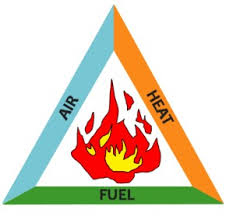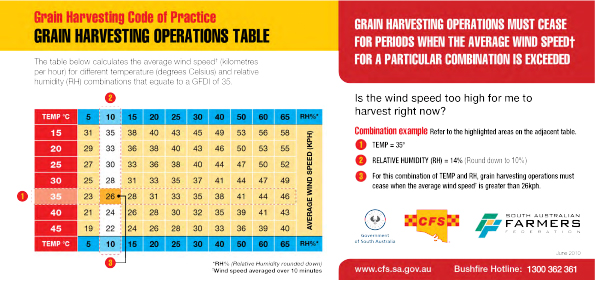Pulse DUST makes harvester hygiene a MUST!!
Pulse Australia and Australian Custom Harvesters
Take home messages
- The best fire protection kit is to INCREASE your risk protection measures.
- Machine maintenance and Machine hygiene are the two biggest factors to DECREASE your fire risk.
Harvesting season in Australian cropping areas can be a stressful time for farmers and professional contract harvesters. Harvest usually occurs under hot dry conditions when the risk of fire is increased and a fire can damage crops, machinery and property, not to mention the risk to lives of the community as well.
The proximity of flammable material to heat sources such as hot exhaust manifolds and turbochargers along with high ambient temperature, low humidity and windy conditions in the paddock, make this a potentially flammable situation.
To make matters worse there are some crops with physical characteristics that increase the risk of fire. These include many of the pulses such as chickpeas, lentils and field peas.
Hazard and risk of fire
For a fire to start we can look at the Triangle of Fire to understand the mechanism. Three things are needed for a fire: HEAT + FUEL + AIR...... and in the context of harvest operations we have all these in abundance.

Heated ignition sources can be in different areas, including:
- around the engine bay of the header such as the exhaust manifold or the tubocharger where temperatures can get up to 650°C
- mechanical failures from bearings
- sparks from electrical short circuit
- striking metal fences or rocks to cause a spark
- static electricity from moving parts or operators clothing
- foreign objects that are taken into the header
Fuel sources can include:
- the dried standing crop itself
- crop residue that has been chopped finely to create an ideal fuel for instant ignition
- flammable fuels and oils used in the header
- dust that carries crop residue
Oxygen (air) is being blown around inside and out of the header.
Increased risk with pulses
Many of the pulse crops come with an increased fire risk because of certain characteristics of the residues.
Chickpeas have high concentrations of malic and oxalic acid exuded from the fine leaf hairs, which causes the residues to stick together inside the header. This can lead to a buildup of fine particles that are extremely combustible.
Lentils also have a very fine residue that can stick to the header and to dust particles.
In addition both these crops have pods very close to the ground so the header front is working virtually on the ground and can easily strike a rock, causing sparks to ignite the fine powder.
Peas, lupins and faba beans also have fine residue that powders easily and create higher risk of ignition. Advice from Canada suggests that diseased crop leaves are a higher risk of fire at harvest.
All of these crop residues may well have much lower ignition temperatures than cereal crops. Sunflower residue was found to have 30 °C < lower ignition temperature in a US study (Polin et al. 2013) and it has a similar reputation to many of these pulse crops.
Reducing the risk of header fires
There are several important things that reduce the risk of fires.
- Initial paddock preparation. Clear all rocks and sticks and roll the paddock to give an even, flat surface that is suitable for harvesting low to the ground.
- Operate harvesters only when the conditions are favourable under the Grain Harvesting Code of Practice (below) FDI 35
- Delegate someone be 'in charge' of checking FDI 35, be it monitoring local weather station or take reading themselves.
- Diligent, regular clean down of residues especially with lentils, chickpeas and field pea crops. Clean all cereal straw out of and off, every surface of the machine before starting in pulse crops. Pulse crop residue may smoulder. It’s the cereal straw that will make the fire get out of control very quickly.
- Check under guards and covers for build up of dust and chaff.
- Check all knife guards and knife sections for damage or misalignment. Bent guards will cause heat build-up.
- Check bearings and moving parts for hot spots (use a hand held digital thermometer)
- Check electrical system for worn cables (esp. for rodent damage)
- Fix all fuel and hydraulic leaks.
- Use a drag chain to avoid build up of static electricity.
- Use the battery isolation switch when the header is not in use.
- Locate fire-fighting gear close to the paddock. A small garden water sprayer located in the cabin can help extinguish small fires.
- Have a bare earth 'safe' area to park machinery for servicing.
- Train all staff in using firefighting equipment.

Use of fire suppression systems on the header
There are several systems that can be put on the header to prevent fires or to deal with fire if it starts.
Fire Knock Out will drench the engine bay in fire retardant using a self actuating switch.
Fire Prevention Shield reduces the temperature of the components in the engine bay by drawing air from the cooling fan through a heat exchanger, charging it to higher pressure to clean residues from around the muffler. This effectively reduces residues and temperature to lower the risk of fire.
Carrying a small hand pumped water sprayer in the cabin to extinguish any fires ASAP.
References
- The Fire Triangle Wikipedia
- Quick (2010) Harvester Fires Final Report GRDC
More information
Phil Bowden Pulse Australia Agronomist (NSW)
Mob 0427 021 946 Email phil@pulseaus.com.au
Paul McIntosh Pulse Australia Agronomist (Qld)
Mob 0429 566 198 Email paul@pulseaus.com.au
Rod Gribble Australian Custom Harvester Contractor
Mob 0427 614 549 Email mail@rcgribble.com.au


